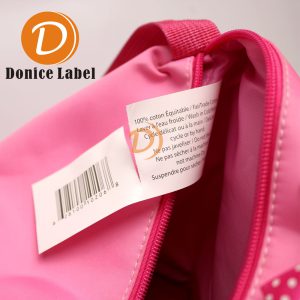Cleaning labels
### **Cleaning Labels**
**Cleaning labels** are essential components of garments, textiles, and other products, providing clear instructions on how to care for and clean the item without causing damage. These labels are typically sewn into or attached to the product, offering guidance on washing, drying, ironing, and dry cleaning. The main purpose of cleaning labels is to ensure that the product retains its quality, durability, and appearance for as long as possible, even after multiple cleaning cycles.
#### **Key Features of Cleaning Labels:**
1. **Washing Instructions**
– **Machine Wash**: The label provides details on whether the item can be machine washed, along with the recommended water temperature (e.g., cold, warm, or hot). Symbols or text may specify whether the garment should be washed on a delicate or normal cycle.
– **Hand Wash**: Some items, especially delicate fabrics, may require hand washing. This will be indicated by a symbol of a hand in a tub of water.
– **Water Temperature**: Washing symbols often include a number of dots inside a tub icon to indicate the maximum water temperature (e.g., 30°C, 40°C, or 60°C).
2. **Drying Instructions**
– **Air Dry**: A line under the washing tub symbol indicates that the item should be air-dried to avoid shrinking or fabric damage.
– **Tumble Dry**: If the garment can be tumble-dried, the label will provide instructions about the temperature setting (low, medium, or high) through dots inside a square.
– **Do Not Tumble Dry**: A symbol with a crossed-out circle indicates that tumble drying is not recommended for the garment.
3. **Ironing Instructions**
– The ironing symbol provides guidance on the appropriate heat setting (low, medium, or high) for ironing.
– **No Ironing**: If the garment should not be ironed, an “X” through the iron symbol will appear.
4. **Bleaching Instructions**
– **Bleach Allowed**: A triangle without an “X” indicates that bleach can be safely used on the garment.
– **No Bleach**: An “X” through the bleach symbol means the item should not be exposed to bleach or bleach-based products.
5. **Dry Cleaning Instructions**
– **Dry Clean Only**: A circle symbol with a letter (like “P” or “F”) indicates that the item must be dry-cleaned using a specific solvent.
– **Do Not Dry Clean**: A circle with an “X” indicates that dry cleaning is not suitable for the fabric.
#### **Types of Cleaning Labels:**
1. **Woven Labels**
– Made by weaving the care symbols and text directly into the fabric, woven labels are durable and long-lasting, ensuring that cleaning instructions remain intact through multiple washes.
2. **Printed Labels**
– Printed cleaning labels are often more cost-effective but may fade over time, especially when exposed to frequent washing. They are typically used for mass-produced garments.
3. **Heat Transfer Labels**
– These labels are applied using heat to transfer the care symbols and instructions onto the fabric. Heat transfer labels are soft and smooth, providing a comfortable feel for the wearer.
4. **Taffeta or Satin Labels**
– Taffeta and satin labels are smooth and shiny, providing a premium appearance. These are often used in higher-end or luxury garments.
#### **Why Cleaning Labels Are Important:**
1. **Protect Garment Quality**
Cleaning labels help prevent garment damage by providing the proper instructions for washing, drying, and ironing. Incorrect care can cause fading, shrinkage, or fabric deterioration.
2. **Extend Product Lifespan**
Proper care instructions ensure that the product retains its quality over time. Following the cleaning label’s guidance helps extend the lifespan of clothing and textiles, saving money for both consumers and manufacturers.
3. **Prevent Environmental Damage**
By avoiding improper cleaning practices, such as excessive heat in washing or drying, cleaning labels help preserve the garment’s color, shape, and texture, reducing the need for replacements.
4. **Consumer Satisfaction**
Clear and easy-to-follow cleaning labels lead to higher consumer satisfaction, as they are empowered to care for their purchases properly. This minimizes frustration and maximizes the usability of the product.
5. **Compliance with Regulations**
Many countries have legal requirements for textile labels, including care instructions. Cleaning labels ensure that manufacturers comply with industry regulations, providing transparency and accountability.
6. **Eco-Friendly Considerations**
Modern cleaning labels may also include eco-friendly symbols or guidelines for caring for garments in a sustainable way, like using energy-efficient washing settings or recommending washing at lower temperatures.
#### **How to Read Cleaning Labels:**
1. **Start with the Washing Instructions**
Look for the washing tub icon, which will tell you if the item is machine washable or requires hand washing. Note the temperature and cycle type (delicate, normal, etc.).
2. **Check the Drying Instructions**
Look for symbols related to air drying or tumble drying. This will inform you about how to dry the item safely to avoid damage.
3. **Review the Ironing Instructions**
The ironing symbol will tell you whether you can iron the garment and, if so, the recommended temperature for ironing.
4. **Identify Bleach and Dry Cleaning Information**
Check for any symbols indicating whether bleach is safe to use or if the item should be dry cleaned.
5. **Double-Check for Additional Warnings**
Some labels may include additional care information, such as warnings about specific fabrics or usage guidelines (e.g., “wash separately” or “do not wring”).
#### **Conclusion**
**Cleaning labels** are critical to maintaining the integrity and longevity of garments and textiles. By offering clear and accurate care instructions, cleaning labels help consumers properly wash, dry, iron, and care for their items, ensuring that they remain in good condition over time. With a variety of materials and symbols to choose from, manufacturers can create cleaning labels that best fit the garment’s needs while adhering to industry standards. For consumers, reading and following the cleaning label is essential for preserving the quality of their clothing and other fabric products.
Showing the single result
